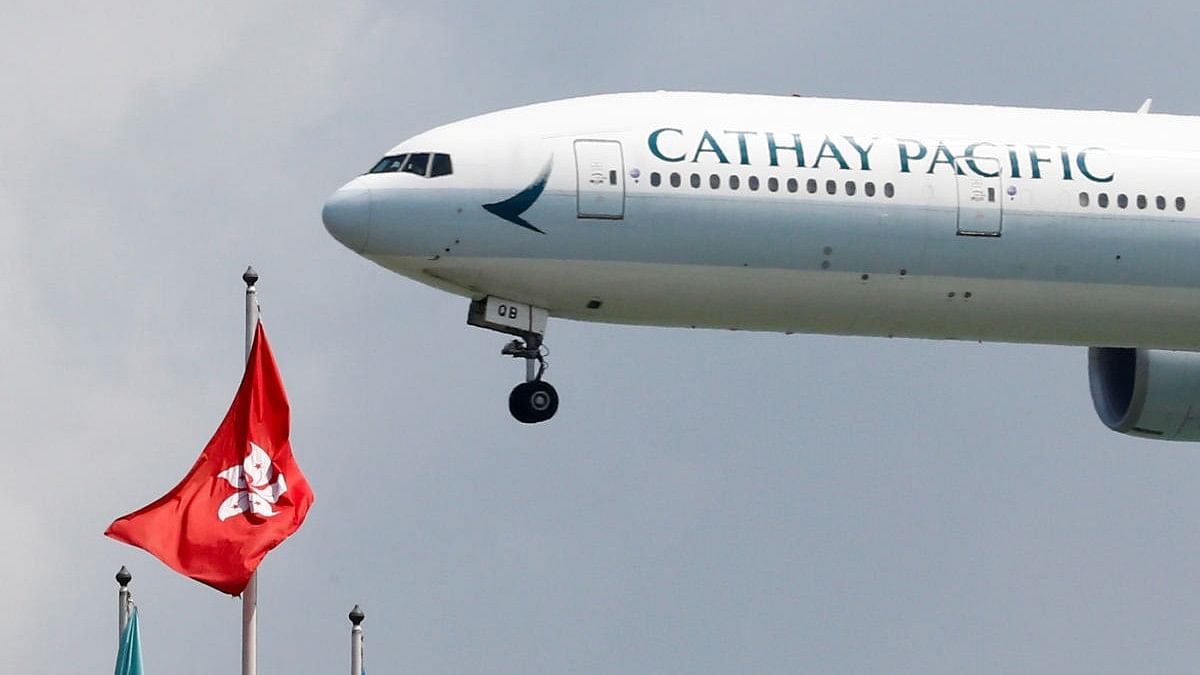
A Cathay Pacific aircraft.
Credit: Reuters File Photo
By David Fickling
We don’t yet know the details of the problem that caused Cathay Pacific Airways Ltd. to cancel flights and inspect its entire fleet of Airbus SE A350 aircraft after finding issues with its Rolls-Royce Holdings Plc engines.
But one thing is certain: As the world struggles to slow rising emissions from jet travel, we’re pushing technology so close to its limits that defects are close to inevitable.
Eking more power out of every gallon of jet fuel was a driving force in the aerospace industry long before climate change became a concern. Kerosene makes up about a quarter of costs for most airlines.
Everything from the A350’s fuselage (made primarily from huge, lightweight sheets of woven carbon fiber) to the upward-bending winglets at the tips of its wings (which help to reduce drag) has been optimized to save gas.
Nowhere does this drive for efficiency dance closer to the technological frontier than in the hellish interior of a jet engine. One of the best ways of getting more propulsive energy from fuel is to increase the pressures and heat at which it’s burned. That can save emissions — Airbus claims the long-haul A350 uses 15 per cent less fuel than previous models — but it puts enormous stresses on the materials.
Turbine blades, the ultra-engineered, chocolate bar-sized structures at the heart of the engine, rotate faster than the speed of sound, at temperatures that would melt even the exotic high-performance alloys from which they’re made.
Manufacturers such as Rolls-Royce must use ceramic coatings and cooling air to prevent them from falling apart. Champion racehorses can often be temperamental beasts, and it’s little different with these cutting-edge components.
The defects behind Cathay’s cancellations may be related to fuel lines feeding the engines, two people familiar with the matter told Bloomberg News on Tuesday.
The XWB-97 engine that’s being inspected by Cathay is one of the highest-performing engines ever made and is already well-known as a demanding machine.
A major driver of the £1 billion ($1.3 billion) jet upgrade program Rolls-Royce announced in July has been concerns among customers about how frequently planes need to be pulled out of service and overhauled.
Emirates President Tim Clark last year described the XWB-97 turbofan as “defective” because of the maintenance requirement. In hot, dusty environments like the home bases of Gulf carriers Emirates, Etihad Airways PJSC and Qatar Airways, airborne particles of sand can melt in the extreme conditions inside the jet and clog up internal cooling systems.
Rolls-Royce is by no means alone in this. A joint venture between General Electric Co. and Safran SA has promised comparable 15% fuel savings in shorter-haul aircraft with their CFM Leap International engine, but it has suffered similar problems.
The Leap is now being redesigned and shortages of turbine blades have slowed deliveries of Airbus A320neo jets. The Leap’s main energy-efficient competitor in the single-aisle jet market, RTX Corp.’s PW1000G, has faced its own teething problems after about 3,000 engines were recalled last year due to impurities in the metal powder used to cast its turbines.
It would be wrong to think of these failures as evidence of incompetence on the part of engine makers. Instead, it’s a testament to the immense difficulty of achieving further improvements in a technology that’s been around for eight decades.
Manufacturers still have plenty of ideas about the sorts of design changes that could thrift fuel consumption even further, but it will probably be decades before the next generation of turbofans cuts emissions another 15 per cent. By that time, any such marginal improvements will have been overwhelmed by the fact that air traffic is likely to triple by 2050.
Sustainable aviation fuels made from crops or captured carbon and green hydrogen aren’t going to help much, either. They’re counted as “sustainable” if they reduce emissions by 10 per cent relative to conventional jet kerosene.
In most cases that’ll do about as much for the environment as an updated jet engine, better winglets, or a smarter booking system that fills more seats — only at vastly greater cost.
The biggest steps toward zero-emissions aviation would come from blue-sky concepts such as electric short-haul aircraft and perhaps hydrogen jets.
Those remain low priorities for aerospace manufacturers, however, so don’t expect to take a commercial flight on one until the middle of this century. As the run of recent problems indicates, engine makers have their work cut out just making their existing designs more efficient.